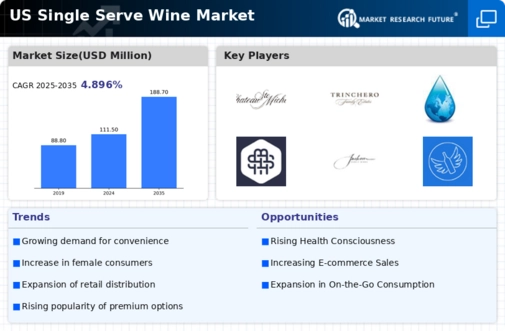The single serve-wine market is currently characterized by a dynamic competitive landscape, driven by evolving consumer preferences and innovative product offerings. Key players such as Barefoot Wine (US), Sutter Home (US), and Apothic Wines (US) are strategically positioning themselves to capture market share through various operational focuses. For instance, Barefoot Wine (US) emphasizes affordability and accessibility, appealing to a broad demographic, while Sutter Home (US) leverages its established brand reputation to introduce new flavors and formats. Apothic Wines (US), on the other hand, targets a more premium segment, focusing on unique blends and sophisticated packaging, which collectively shapes a competitive environment that is both diverse and rapidly evolving.
In terms of business tactics, companies are increasingly localizing manufacturing and optimizing supply chains to enhance efficiency and reduce costs. The market structure appears moderately fragmented, with several key players exerting influence while also allowing for niche brands to emerge. This fragmentation fosters a competitive atmosphere where innovation and consumer engagement are paramount, as companies strive to differentiate themselves in a crowded marketplace.
In October 2025, Sutter Home (US) announced the launch of a new line of organic single-serve wines, responding to the growing consumer demand for sustainable and health-conscious options. This strategic move not only aligns with current trends towards organic products but also positions Sutter Home (US) as a leader in the sustainable segment of the market. The introduction of organic offerings could potentially attract a new customer base, enhancing brand loyalty and market penetration.
In September 2025, Apothic Wines (US) unveiled a partnership with a leading technology firm to integrate augmented reality (AR) features into their packaging. This innovative approach allows consumers to engage with the brand in a novel way, enhancing the overall experience and potentially driving sales. The use of AR technology signifies a shift towards digital engagement, which is becoming increasingly important in the wine industry as younger consumers seek interactive and immersive experiences.
In August 2025, Barefoot Wine (US) expanded its distribution channels by entering into a strategic alliance with a major online retailer, significantly increasing its reach to consumers who prefer purchasing wine online. This move reflects the ongoing trend of digital transformation within the industry, as companies adapt to changing shopping behaviors. By enhancing its online presence, Barefoot Wine (US) is likely to capture a larger share of the market, particularly among younger demographics who favor convenience and accessibility.
As of November 2025, current competitive trends indicate a strong emphasis on digitalization, sustainability, and technological integration within the single serve-wine market. Strategic alliances are increasingly shaping the landscape, allowing companies to leverage each other's strengths and enhance their market positions. Looking ahead, competitive differentiation is expected to evolve, with a notable shift from price-based competition towards innovation, technology, and supply chain reliability. Companies that can effectively harness these trends will likely emerge as leaders in the market.























Leave a Comment